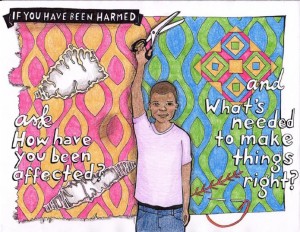organizing
Asking better questions.
October 25, 2016Cultural Organizing:
This disproportionately harms low income Students of Color, exacerbates the large opportunity gaps that already exist, and fosters what has come to be known as the school-to-prison pipeline.
In response, we have seen rapid growth of the restorative justice movement, which offers a radically different approach. Restorative justice asks that we make a paradigm shift in the way we think about “crime” and “misbehavior.” As Dr. Carolyn Boyes-Watson at the Center for Restorative Justice at Suffolk University explains,
“Rather than privileging the law, professionals and the state, restorative resolutions engage those who are harmed, wrongdoers and their affected communities in search of solutions that promote repair, reconciliation and the rebuilding of relationships. Restorative justice seeks to build partnerships to reestablish mutual responsibility for constructive responses to wrongdoing within our communities. Restorative approaches seek a balanced approach to the needs of the victim, wrongdoer and community through processes that preserve the safety and dignity of all.”
Within this realm, practitioners have developed a wide range of “restorative practices” — such as victim-offender dialogues and peacemaking circles — often drawing on conflict resolution practices from indigenous societies around the world. But restorative justice cannot be reduced to a set of practices. It is a way of thinking about and approaching conflict. It requires a shift in how we relate to one another. It is about developing a restorative culture in our schools and communities.
